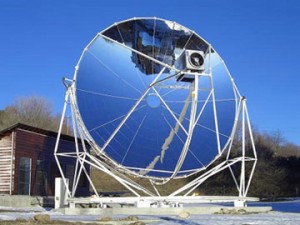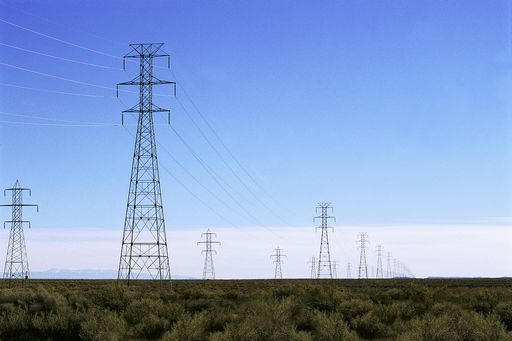Today, two sectors share the capacity of electricity generation from solar energy – photovoltaic conversion (PV) using semiconductors, including silicon, which is growing rapidly in many countries in five years – thermodynamics conversion using solar heat to produce electricity via a heat engine and a generator. These solar technologies contribute together only marginally to electricity production (about 0.5% of world production), but two recent reports from the International Energy Agency (IEA Technology Roadmaps, Solar Photovoltaic Energy, Solar Thermal Electricity, www.iea.org/roadmaps/ ) forecast that they could really take off in the coming years contributing thus very significantly to global electricity production : in 2050, they would represent 16% in respectively PV and 11% for the thermodynamics conversion to be together a little over a quarter of total production. The increase in solar PV installed capacity is spectacular, it would rise today to 100 MW per day (an annual rate of increase in new capacity by 49% !), with a worldwide installed capacity of 150 GW in early 2014. Since 2013, China is the world leader for photovoltaic solar plants, followed by Japan and the United States. In Europe, Germany and Italy are the leaders (7% of the national electricity production by the photovoltaic sector in Italy). Let us recall that the solar power installed in France is only 4.3 GW. Accelerating the development of the solar industry owes much to the falling price of the cells (it was divided by 5 between 2008 and 2012) and according to the IEA the cost of electricity produced in the world would fall in 2014 within a range of 90 to $ 300 / MWh (70-230 € / MWh).
The IEA has revised its 2010 estimates for its Solar 2050 « roadmap »: in 2010 it had proposed a scenario with a 11% share in solar photovoltaic electricity production by 2050, a proportion that it passed to 16% in its new roadmap with an installed capacity around 4600 GW, probably an optimistic estimate. It also believes that production cost would fall sharply, and be in the range of $ 40 to $ 160 / MWh (30 to 120 € / MWh), assuming an 8% capital cost. It will be observed that in 2050 China would represent 37% of global PV installed capacity and also that it already has the market leadership for silicon cells production which it sells at a price of 0.45 € / W, while German solar cells are sold at a price of 0.6 € / W which condemned German industry to withdraw from the market. This scenario assumes a very significant investment, on average, $ 233 billion per year, doubling the 201 level. The intermittency of production and its « dual » character (it is consumed in part by the producer, for example when it is generated by panels installed on rooftops, or distributed into the electrical grid) requires the construction of new lines, « smart grids », and facilities for control and balance networks that would require supplementary investments.
The future of solar thermal sector is probably less « bright » but in its second report, IEA still envisages this future optimistically. Today, this sector is underdeveloped (4 GW of installed capacity worldwide), it requires indeed very favorable sunshine conditions (continuous sunlight during the day) and it is not surprising that most solar thermal power plants (or concentration) have been built in California and Spain (where capacity has been limited to 2.3 GW by government decision) and more recently in Morocco (with a large plant in the Atlas at Ouarzazate). Anyway, the IEA roadmap « forecasts » that the share of solar thermal  energy in electricity production could reach 11% by 2050 with an installed capacity of 1,000 GW. Remember that this industry has the advantage of allowing the storage of solar heat absorbed during the day by storing it in a liquid (a mixture of salts for example), in order to use it during peak hours in the evening in the power plant (it produces steam for turbines), this possibility simplifies the work of the electric network as it can be supplied according to consumer demand. The IEA is cautious about its production costs assessment and their evolution, as it believes, that it very much depending upon the cost of capital invested in the construction of the plant (in the range of 4000 to $ 9000 / kW). Today the Spanish solar plant sells its electricity at a preferential rate of about € 300 /MWh and the Ouarzazate plant to 150 € / MWh. We can consider a variety of scenarios for the future including an hybrid one : the coupling of the photovoltaic and thermal modes, eventually with a thermal gas plant (a solution adopted in Spain in Andalusia).
energy in electricity production could reach 11% by 2050 with an installed capacity of 1,000 GW. Remember that this industry has the advantage of allowing the storage of solar heat absorbed during the day by storing it in a liquid (a mixture of salts for example), in order to use it during peak hours in the evening in the power plant (it produces steam for turbines), this possibility simplifies the work of the electric network as it can be supplied according to consumer demand. The IEA is cautious about its production costs assessment and their evolution, as it believes, that it very much depending upon the cost of capital invested in the construction of the plant (in the range of 4000 to $ 9000 / kW). Today the Spanish solar plant sells its electricity at a preferential rate of about € 300 /MWh and the Ouarzazate plant to 150 € / MWh. We can consider a variety of scenarios for the future including an hybrid one : the coupling of the photovoltaic and thermal modes, eventually with a thermal gas plant (a solution adopted in Spain in Andalusia).
The future is probably still wide open for solar technologies and in particular for the photovoltaic industry. Regarding thermal power, or concentration plants, we can estimate that the techniques are mature, the technical effort will be focused on the synchronization of the mirrors with the sun and on the improvement of the capacity of heat storage by materials. It probably has a future in regions where sunlight is favorable as the United States, southern Europe and North Africa. The vast majority of solar cells are made from silicon and with a performance range of 20-25%. Research is working on an alternative to silicon cells. Semiconductors such as gallium arsenide (GaAs) or cadmium telluride (CdTe) are already on the track, they are used in the cells consisting in layers of different materials. A new path was opened by solid state chemistry in 2011 with materials called perovskites (they usually consist in metal oxides), where an organometallic compound of a halogen (chlorine, bromine or iodine) and a metal such as lead or tin is vapor deposited on a support, the cells having an efficiency of 18% at present, with a voltage higher than that of silicon ; before using them in solar panels one must ensure their stability and try to find an alternative to lead, which is toxic (M. Grätzel, « The light and shade of perovskite solar cells, » Nature Materials, vol. 13 , p. 838, September 2014, www.nature.com/naturematerials ). Note that the efficiency of this new kind of materials made very fast progress as it did not exceed 4% four years ago. These new materials based perovskite may also be used to split water into hydrogen and oxygen using electricity generated by a solar cell consisting of a perovskite and using a catalyst such as a nickel-iron alloy with a 12.3% yield (J .Luo et al., « Water photolysis at 12, 3% efficiency via photovoltaics and earth perovskite-Abundant Catalysts », Science, vol. 345, p.1593, 26 September 2014 www.sciencemag.org ).
Solar electricity production has not probably said its last word and if we accept with caution, the optimistic IEA « forecasts »- its future is supposed to be « bright » – it should certainly improve its performance and profitability, which is not acquired, by focusing on new techniques through R&D. Let just recall that the « Energy Transition » bill which is being debated currently in France, while placing a great emphasis on renewable energies in the electricity mix (see the forum in Futuribles « The law on energy transition debate” www.futuribles.com/fr/forum-transition-energetique ) is somewhat mute on research issues.
